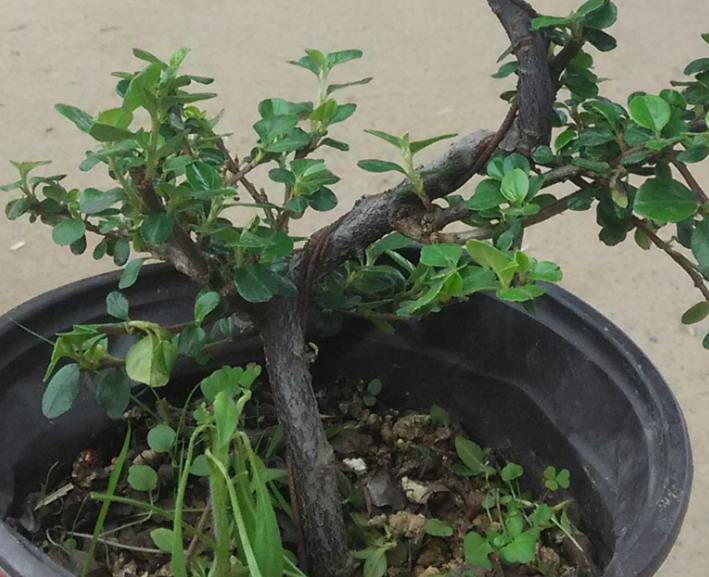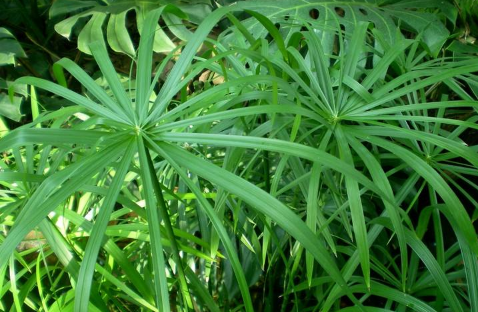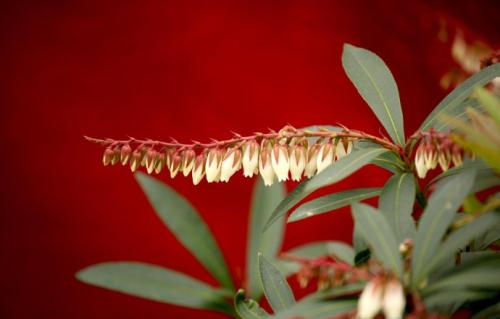Conservation of Pearl Plum Bonsai
Basin soil
Potted soil should choose good permeability, strong drainage capacity, fertile loam. Organic fertilizer was applied at the end of autumn and early winter, and phosphorus and potassium fertilizer was applied before flowering. Usually appropriate amount of watering, to keep the basin soil moist, can not be too wet for a long time, let alone waterlogging. Pot plants should be placed in direct sunlight as far as possible, winter low temperature dormancy is its physiological needs, can not be put into the greenhouse to avoid the next year's growth and flowering, placed in the open air, leeward, sunny place, or cover the basin soil to bury, can safely survive the winter. Pruning the fallen leaves every year before sprouting in the following year, cutting off the diseased and residual branches, dry and withered branches, and the weak ones in the dense branches. Truncate too long branches, so that it maintains a good plant type, ventilation and light, in order to facilitate flowering.

Temperature and light
Pearl Sea is farmed because it likes the environment of room temperature and sunlight. Adult plants can also tolerate cold and semi-shade. The seedlings of cutting in autumn are in the following summer, which happens to be the period of tender shoots and leaves growing.
Fertilizer application
Fertilization requirements are not high, just cultivated when the need to apply sufficient base fertilizer, can meet the requirements of its growth, generally no longer topdressing. In the future, combined with winter management, base fertilizer can be applied once every 1-2 years.
Pruning
After the pearl plum blossom fades, the inflorescence is withered and yellow, which affects the aesthetics, so the residual inflorescence should be cut off to make the plant clean and tidy, and avoid the residual inflorescence competing with the plant for nutrients and water. After autumn or early spring, disease and insect branches and old and weak branches should be cut off, and annual branches can be strongly pruned to promote the renewal of branches and luxuriant flowers and leaves.
Watering
Watering should be carried out in time when the spring is dry, and when the summer and autumn are dry, the water should be thoroughly watered to keep the soil moist, and a watering should be carried out before winter.
For more information about Pearl Plum, please follow the four Seasons Plant Network!
How to raise bonsai of pearl plum and the culture method of pearl plum
Pearl plum, also known as snowflakes, deciduous shrubs, 2-3 meters high. Branches spreading; branchlets curved, glabrous or puberulent, light green when young, dark yellowish brown or dark reddish brown when old. Elegant white flowers bloom in midsummer and bloom for a long time. Pearl plum is also often used to make bonsai. This article introduces how to raise bonsai and how to raise it.
How to raise bonsai of pearl plum
The main results are as follows: 1. it is not strict with the soil, but it grows better and blossoms more luxuriantly in the deep and fertile sandy soil.
2. The requirement of fertilization is not high, and it is necessary to apply enough base fertilizer to meet its growth requirements, and generally no more topdressing. In the future, combined with winter management, base fertilizer can be applied every 1-2 years.
3. It should be watered in time when it is dry in spring, thoroughly watered in summer and autumn in order to keep the soil from drought, and need to be watered once before winter.
4. After flowering, the residual flower branches, disease and insect branches and old and weak branches should be pruned in time to keep the plant type neat, avoid nutrient consumption, and promote its robust growth and luxuriant flowers.
Culture method of Pearl Plum
Pearl plum has strong adaptability and does not have high requirements for fertilizer. except for a small amount of base fertilizer for newly planted plants, it does not need rotating fertilizer, but it needs watering. Generally, it is watered 2-3 times during the period from leaf bud germination to flowering, and the Beginning of Autumn is watered 2 or 3 times from post-frost to frost, including anti-freezing water, which is watered according to drought in summer and needn't be watered when it rains a lot.
The inflorescence of pearl plum blossom is withered and yellow, which affects its appearance, so the residual inflorescence should be cut off to make the plant clean and tidy, and avoid the residual inflorescence competing with the plant for nutrients and water. Diseases and insect pests and old and weak branches should also be cut off after autumn or early spring, and annual branches can be strongly pruned to promote the renewal of branches and the flourishing of flowers and leaves.
When the weather is dry, the soil should be watered in time to keep the soil moist, anti-freezing water should be watered once before winter, flower branches should be cut off immediately after flowering, old and weak branches should be cut off before winter, sufficient basic fertilizer should be applied before new plants, and fertilized once every 2-3 years.
On the pearl plum bonsai how to raise and pearl plum breeding methods are introduced here, hoping to help you better care of pearl plum.
When does Pearl Plum blossom? How to raise bonsai of pearl plum
Is there anyone who likes to raise pearl plums? When will the pearl plum brought to you by today's flower bonsai network blossom? The article on how to raise pearl plum bonsai, see how pearl plum bonsai can be raised well, right?
When does Pearl Plum blossom?
Pearl plum is a kind of shrub, tall, the branches are unfolded, the flowers are mostly white, like plum blossoms, there are pearl-like pearls on it in September, so when will it blossom?
The florescence of Pearl Plum
Pearl plum mostly grows in hillside forests, distributed in Liaoning, Heilongjiang and other places, its flowers are mostly white, beautiful and fragrant, and its flowering period is usually from July to August.
Factors affecting the flowering of Pearl Plum
Pearl plum is not strict with the soil, but the soil should also have certain nutrients, preferably in the sandy soil, otherwise it will affect the flowering.
The flowering pruning of Pearl Plum and the prevention and control of diseases and insect pests will also affect the flowering.
Powdery mildew of Pearl Plum will affect flower growth and flower bloom.
Maintenance measures for the flowering of Pearl Plum
If Pearl Plum wants to blossom and blossom well, we must first choose fertile sandy soil for cultivation, which is conducive to plant growth and early flowering.
The second is to prune the branches after flowering, cut off the remaining flower branches, leaving healthy flower branches, which is more conducive to the growth and opening of flowers.
Finally, the treatment of diseases such as powdery mildew, powdery mildew will appear white powder hinder the growth of flower buds, so it is necessary to prevent and control, pay attention to ventilation and reduce the humidity of the air. Increase the light and apply phosphate fertilizer properly. Attention should also be paid to cutting off the parts of the disease, spraying drugs, and spraying 70% methyl topiramate 800 times or 50% benzoylammonium 800-1000 times in the early stage of the disease.
The Flower language of Pearl Plum
Pearl plum represents not only a kind of pure and profound friendship, but also the lofty ambition of hard work.
How to raise bonsai of pearl plum
The maintenance of pearl plum bonsai mainly lies in the details such as temperature, watering, basin soil and so on. The maintenance of bonsai pearl plum is not as extensive as that planted on the ground. We should pay attention to whether the potted soil needs to be watered in time, and colleagues should trim the branches and leaves regularly. Only in this way can we better show the benefits of pearl plum bonsai.
Basin soil
Potted soil should choose good permeability, strong drainage capacity, fertile loam. Organic fertilizer was applied at the end of autumn and early winter, and phosphorus and potassium fertilizer was applied before flowering. Usually appropriate amount of watering, to keep the basin soil moist, can not be too wet for a long time, let alone waterlogging. Pot plants should be placed in direct sunlight as far as possible, winter low temperature dormancy is its physiological needs, can not be put into the greenhouse to avoid the next year's growth and flowering, placed in the open air, leeward, sunny place, or cover the basin soil to bury, can safely survive the winter. Pruning the fallen leaves every year before sprouting in the following year, cutting off the diseased and residual branches, dry and withered branches, and the weak ones in the dense branches. Truncate too long branches, so that it maintains a good plant type, ventilation and light, in order to facilitate flowering.
Temperature and light
Pearl Sea is farmed because it likes the environment of room temperature and sunlight. Adult plants can also tolerate cold and semi-shade. The seedlings of cutting in autumn are in the following summer, which happens to be the period of tender shoots and leaves growing.
Fertilizer application
Fertilization requirements are not high, just cultivated when the need to apply sufficient base fertilizer, can meet the requirements of its growth, generally no longer topdressing. In the future, combined with winter management, base fertilizer can be applied once every 1-2 years.
Pruning
After the pearl plum blossom fades, the inflorescence is withered and yellow, which affects the aesthetics, so the residual inflorescence should be cut off to make the plant clean and tidy, and avoid the residual inflorescence competing with the plant for nutrients and water. After autumn or early spring, disease and insect branches and old and weak branches should be cut off, and annual branches can be strongly pruned to promote the renewal of branches and luxuriant flowers and leaves.
Watering
Watering should be carried out in time when the spring is dry, and when the summer and autumn are dry, the water should be thoroughly watered to keep the soil moist, and a watering should be carried out before winter.
- Prev

The method of preventing rotting Root of Upland Grass
1. The reason of water quality: Upland grass has high requirements for water quality, and the turbid water quality is easy to breed bacteria and affect root respiration, resulting in rotting roots. Prevention and treatment: change the cold boiled water every two days in summer, increase the change of water and wash the root mucus, which can effectively prevent rotting roots.
- Next

The culture method of Majiu wood
First, the temperature of horse drunk wood can not bear high temperature, afraid of direct light, the most suitable temperature for growth is 10 to 15 degrees. Second, fertilizing mahogany needs enough fertilizer when it grows, so fertilize it every once in a while, but be careful not to get on the leaves.
Related
- Fuxing push coffee new agricultural production and marketing class: lack of small-scale processing plants
- Jujube rice field leisure farm deep ploughing Yilan for five years to create a space for organic food and play
- Nongyu Farm-A trial of organic papaya for brave women with advanced technology
- Four points for attention in the prevention and control of diseases and insect pests of edible fungi
- How to add nutrient solution to Edible Fungi
- Is there any good way to control edible fungus mites?
- Open Inoculation Technology of Edible Fungi
- Is there any clever way to use fertilizer for edible fungus in winter?
- What agents are used to kill the pathogens of edible fungi in the mushroom shed?
- Rapid drying of Edible Fungi

